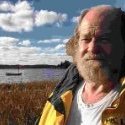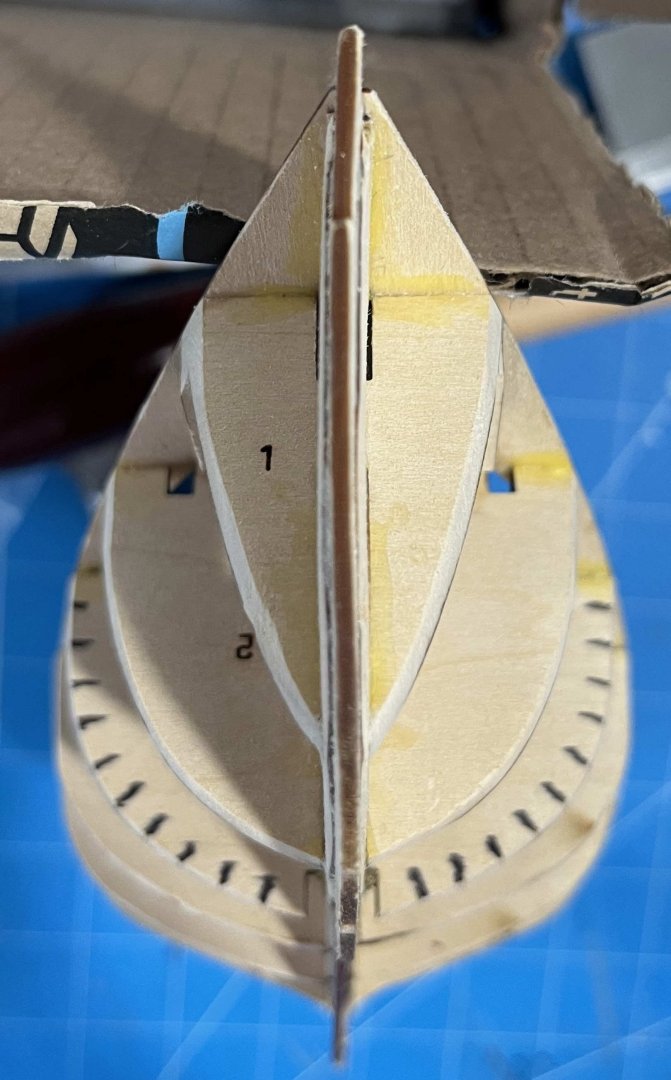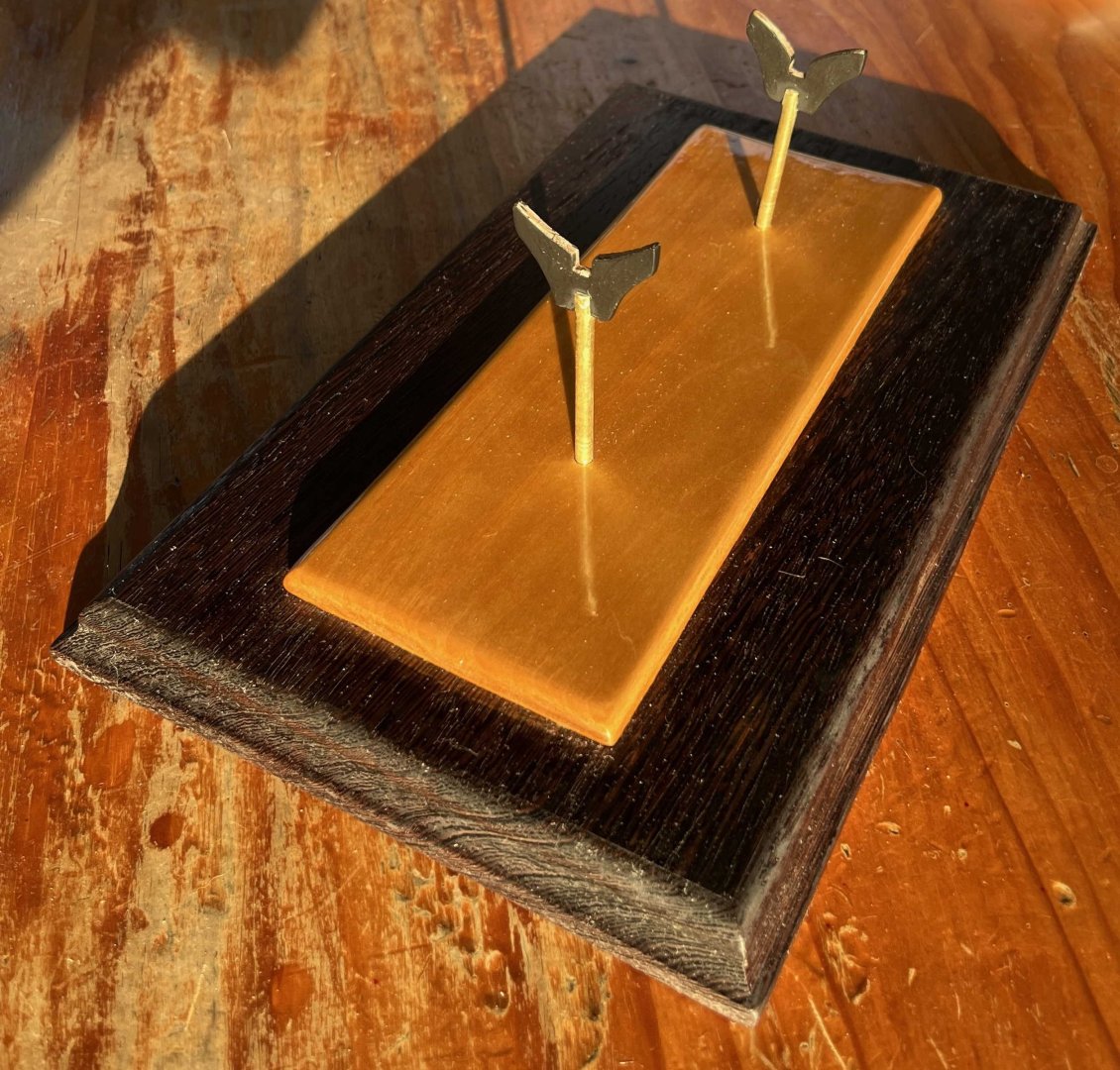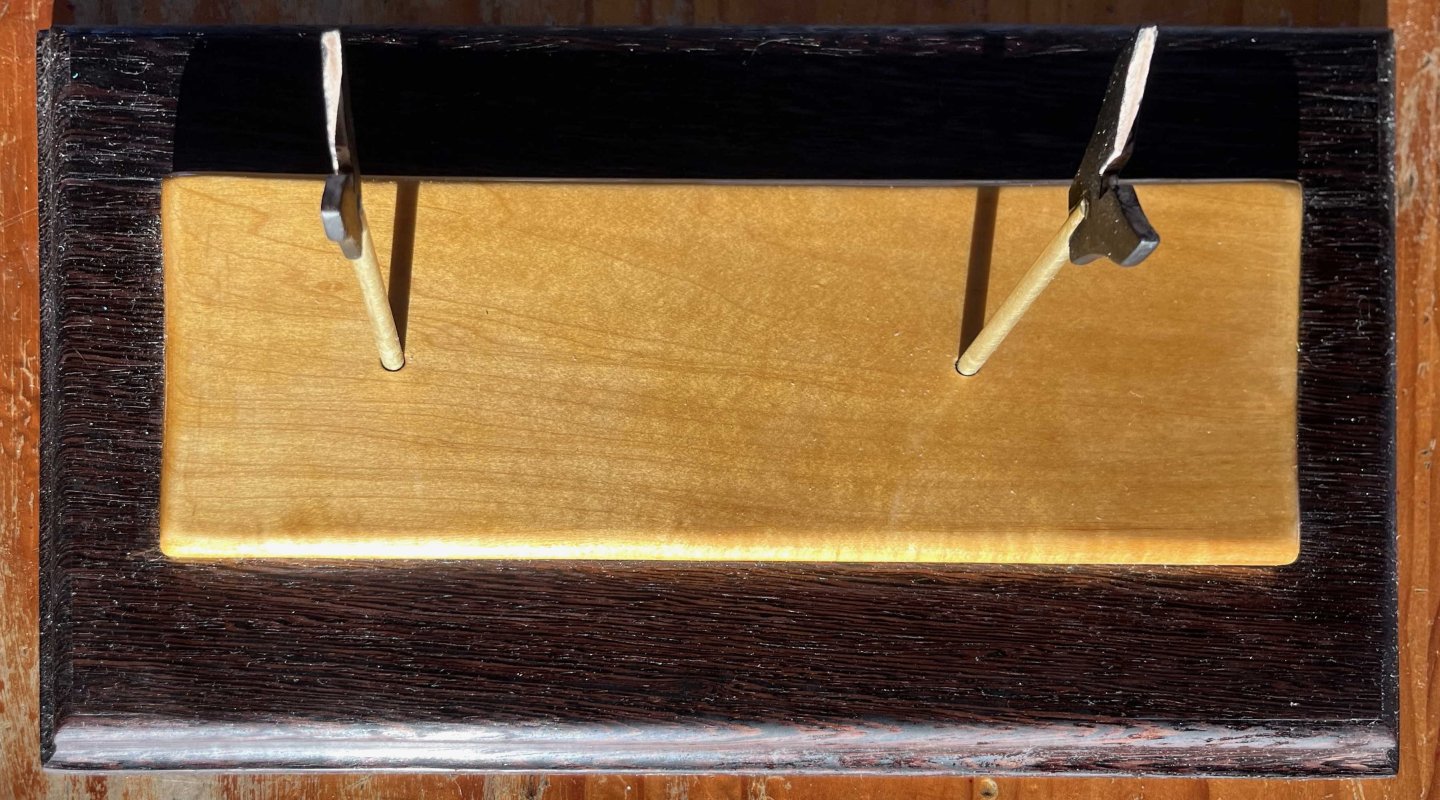-
Posts
662 -
Joined
-
Last visited
Content Type
Profiles
Forums
Gallery
Events
Everything posted by Kenchington
-
Michael, Admiral Smyth, writing about the time of Flying Fish (though often with reference to much older sources) limited the meaning of "yard" to square, lateen and lug yards (each spreading the head of a sail, while crossing a mast), whereas he saw "booms" as extending outwards and spreading the feet of sails. I guess you could say that they are fixed at one end but there's a big difference between the boom of a gaff sail, pivoting at the mast end, and a jibboom or stuns'l boom, which can be slid in or out but (when in use) is fixed so as not to pivot. Then there were Bentick booms, which crossed a mast (like a yard) but spread the news of a squaresail. I'm sure that we could come up with many other kinds of booms too! Trevor
-
Perhaps assorted flying kites added later as the ships were put into trades where more and longer periods of light winds could be expected? Record speeds should come on days of strong, steady winds, though not in truly heavy-weather -- with the border between "strong" and "heavy" depending in the size and type of vessel. Skys'ls, t'gallant stunsl's and the like were more to maintain speed when the wind fell light than to push up the overall maximum, so likely not set when records were being broken. Trevor
-
Technically "yards", not "booms", though I would be hard pressed to define the difference. (Yards spread the heads of sails and booms the feet, maybe? There are probably multiple exceptions to any simple division like that.) But, yes, I am saying that the ship in the second image was rigged to carry skys'ls but the yards are not shown. When the wind was expected to be unsuitable for such light-weather canvas for an extended time, instead of the yard being left aloft, the robbands cut and the sail sent down to the deck, the sail was left furled on its yard and the whole thing sent down as one package. It could readily be send aloft again when needed. That was entirely normal in the clipper era (and for centuries before) but became impractical with the heavy, steel rigs of the late 19th Century. The ship in the background of each painting might be worth close study. There was a genre of ship portraits in which the same vessel was shown in 2 or 3 positions, often one sailing free and another close-hauled and/or in stern view. You may have four views of Flying Fish in two paintings. Trevor
-
Step 9, Fairing, completed. It proved much easier than I feared -- though until I get to planking, I won't know how well I did at this stage. The upper tips of the bulkheads were easiest: Just sand each one flush with the deck edge. In the end, I only had to add two shims, one of them where I had to re-shape the stern. The bottom of the bulkheads were a little more tricky, though they only needed to reach a feather edge at the end of the outer layers of the central spine structure. Sanding the bulkheads between those limits lacked such easy guidance but the instructions recommendation of a sanding stick-cum-batten (120-grit paper glued to a length of 1/32 basswood) made the midships portion of the hull easy enough. I just sanded until no bulkhead had more than a fine line of char (if any), while the batten worked comfortably across adjacent bulkheads. I did check for port-starboard symmetry, but no issues amidships. The greatest challenge towards the bow was in cutting away the edges of the outer layers of the spine, to form a bearding for the planks. The instructions recommend a knife but I have more control when sanding, so just worked gradually to and fro until happy with the result. I did take extra care to get symmetry between the two sides of Bulkhead 1, as asymmetries there will be especially noticeable when the planking is viewed from ahead. All those issues were more complicated at the stern. One point that the instructions do not mention is that the centreline abaft the sternpost needs to be flat (transversely) and only slightly curved longitudinally, so that it can take a centre plank (in Step 10). That meant a lot of sanding but it is an easy shape to make and then provides a guide to the rest of the fairing in that area. For the hollow sections (mostly Bulkheads 7 & 8), the instructions recommend using sandpaper glued around a dowel. I used an old white-board marker pen (larger diameter) and a pencil (narrow), plus some narrow sanding strips. Getting the basic shape was then no harder than the bow but working for port-starboard symmetry was more demanding. Then came shaping the bearding along the edges of the outer spine pieces, followed by re-shaping everything else. A re-check of my notes then reminded me that previous builds have run into problems where the hollowed, "wineglass" portion of Bulkhead 8 (low down towards the keel) was too wide, making it hard to draw the lower planks to the sternpost. So I did a bit more sanding there. Another problem seems to be bulges in the planking over Bulkhead 7 (worsened by narrowing #8), so I went to some extra effort to get smoothly flowing curves across bulkheads 6 to 9. And then a repeat effort to ensure symmetry. Hopefully, all is done but I won't know until I get to planking, by which time it will be too late for changes! For now, it looks like:
-
The first two show her rigged for 5 squaresails on each mast: course (cro'jick on the mizzen), topsail, t'gans'l, royal and skys'l. The first has the skys'l yards crossed but the sails furled (as are the fore and mizzen royals). The second shows all royals, plus the fore and mizzen t'gans'ls furled, while the skysail yards have been sent down -- as would be expected if stronger winds are forecast to persist for more than several hours. In typical square rigs, any time there is a stay (leading forward) and shrouds, they mark the upper end of a "mast" (even if that is made of the same continuous pole as the mast below and the flagpole above), which is there to carry a yard and sail. The skys'l-mast stays and shrouds are clear in that painting, showing where the skys'l yards would go if they had not been sent down. I think you can be sure that, in terms of terminology of the time, she was a "three-skys'l yarder". Trevor
-
As for many people who follow through the ModelShipways "Apprentice" trio, this smack will be my first experience of a Plank-on-Bulkhead build. While properly stretching our capabilities, as part of the learning experience, David Antscherl has set us a couple of extra challenges. For one thing, the kit has single-layer planking: No rough initial layer, with much sanding and filling before neat, outer planking ones on. Secondly, the smack's hull has some very awkward curves where the run transitions into the counter. Meanwhile, the symmetry of the deck is emphasizing the slight irregularities in my placing of the bulkheads. I figured that I could be less careful that when planking the dory or pram, as any problems could be addressed while fairing. They can be and will be but I will need to shim Bulkheads 5, 8 and especially 10, all on the port side. Not a big deal but one more task. First, however, I extended the laser-burnt tick marks for the strakes, on Bulkheads 3, 6 and 9. A fine-point Sharpie made nice marks but I couldn't get those exactly perpendicular to the edge of each bulkhead, so they will be in the wrong places once those edges have been faired away. I think my marks will still be good enough as guides, which is all they can be anyway. But for anyone following this log in the future: Extend those tick marks before fitting the bulkheads to the spine. That way, you can use a ruler and square to get more accuracy. Starting fairing now ... Trevor
-
Tidied up the deficiencies in the deck today. The big one was right aft. I whittled a wedge of balsa to take future planking and inserted it where the skeleton of the hull was fell short of the deck: Then I shaped the forward edge of an extra, transverse "plank" for the stern, leaving lots of surplus. Glued in place, that looked a mess: But once sanded and trimmed, with a vertical edge at the extreme stern (as called for by the instructions), it looked quite nice: There is more shaping to do, below the deck's sheer line, but that will come with fairing, planking and the likely filling of hollows here and there. By the time that last image was taken, I had brushed on a first coat of Wipe-on-Poly -- brushed as I wanted to keep it clear of points where glue should go in future, though I didn't succeed as well as I should have. Still, while awaiting a second coat of Poly, I have: The extra piece added across the ends of the planks, at the forward end of the cockpit, is basswood scrap but dipped in golden-oak stain, mostly just for the effect of the visual contrast but also the suggestion of a hardwood edge protecting the exposed corner and the end grain. I doubt that that was normal on Muscongus Bay centreboarders but they certainly could have been built that way if anyone wanted to. Aside from a gentle sanding and a second coat of Poly later this evening, that brings the model to completion of Step 8 of the instructions. Next up: Fairing the hull. Trevor
-
Michael, You asked: Names of species, like names for boat types, get re-used for all sorts of things, often ones quite different to the original meaning. But all of the "true" trouts, salmon and chars are in the family Salmonidae -- which contains 240 species by one count. The chars are in the genus Salvelinus, the Pacific salmons (along with some species called "trout") are in Oncorhynchus, Atlantic salmon (the original and best!) plus a bunch of trout species are in Salmo. But don't get me started on biological names for weird fish species. I'm finally tidying up a list of 250 from deepwater surveys we ran nearly 20 years ago and some of those were seriously weird! And: Been there, too: The kind of weather when you run for shelter after the worst has passed, because you can't while it is blowing. In my case, we had Argentina as the nearest land upwind and Chile somewhere to leeward, with a whole lot of empty ocean between in both directions. But I've worked with commercial fishermen who had seen far worse in far smaller vessels. Then again, I've known people who never came home. Trevor
-
Thanks, @ccoyle! I was afraid that I was using ship-modelling bandwidth for a bit of personal reminisce. Salmonids are a different game to marine fisheries, with habitat modification (for better or worse) being a big part of their story. Most (not all) habitat change offshore is beyond the bounds of human intervention, so my career has been more about fishing people and fishing boats impacting on the fish and being impacted in their turn. But now I need to figure out how to represent a keg of dead fish, as 1:24 lobster bait! Trevor
-
The standard rowing position on my full-size boat has me astride the centre plate case, so free to move fore or aft until comfortable. When making up a removable thwart for the forward rowing position, I just got settled in the after one and measured from my seat to the rowlocks. A bit empirical but it works! I agree that the boat really needs stretchers for the oarsmen's feet. McKee named them in his booklet but did not include them in his card model. Maybe something to add? Trevor
-
I have to correct an error in the "parts list". I had: Taking a bit more care in studying McKee's words, I realized that the "skirting rails" are fastened to the timbers on either side of the bottom boards, which fit between those rails, not on them. The boards are held together by being nailed to cross battens, though there is something unclear. McKee says that the boards are made in port and starboard halves, so the battens cannot span across the hull. What stops them from collapsing along the centreline? Maybe the battens rest directly on the hog, though that would put the boards very near the bottom of the boat. Maybe there was an extra, lengthwise batten nailed to the hog for the cross battens to rest on. Perhaps the answer will come clear as construction proceeds. McKee does say that the bottom-board halves were kept in place by three turnbuckles evenly spaced down the centre of the hog -- which seems to mean that the boards themselves did not meet on the centreline, even though the ends of the cross battens likely did. He is even less clear about the sternsheets -- by which he meant the place for the feet of anyone sitting aft (rather than the after seats or the general after seating area, as in the historical meaning of the term). He does say "secured by screws" but may have meant that for the seating rather than the foot support. In his glossary, he calls the sternsheets a "level platform", suggesting a continuous surface rather than one with gaps between boards. Whether fixed in place or removable, built of boards, a sheet of plywood or even a grating, the sternsheets will need some support underneath. The card model has fold-down ends that rest on the hog and the planks, so there should probably be two cross timbers (one each end of the sternsheets), with space for limber holes either side of the hog. If I'm feeling really silly by the time I get that far, maybe I will try making an elegant grating to fill the space! Trevor
-
Then I can welcome an old shipmate to MSW! You and I probably worked side by side in the wet lab, all those years ago. I wasn't on any squid cruises and had no contact with DFO's squid scientists at that time, though I did brush up against the people at Dalhousie, who got the squid to spawn in the Aquatron tank. (Maybe ones your brought in live?) And I do remember the Hammond's hopper full of tons and tons of the oily beasts. As you likely know, they have occasional exceptional years and one came in the early '80s. Trevor
-
Michael: I'm impressed! I could not have handled hydrographic surveys, let alone on-board model building after a day in those survey launches. Hammond Innes was probably the finest, most successful distant-water wetfish trawler the British ever built -- as well as almost the last of them. I still have soft spot for her in my heart. But as a research trawler, I have to agree: She was a bitch. In a sick way (pun intended), I'm glad you had the same trouble I did. I got on well with the Chief Engineer (both of us being Limeys) and he insisted that he knew how to ballast a trawler. I was never sure that he understood the difference between a ship with a hold full of ice and fish, versus one with only scientific gear and a lot of ballast down there. Even so, Prince was worse, once she was used outside the Gulf. And the Templeman/Needler pair, amongst their other problems, had the accommodation for the scientific party up forward, so they gave us little rest. Then again, the Australians, who could have had the Hammond's sister, C.S. Forester, bought the much-smaller, French Soela instead. She was a lot of fun in a 75-knot gale on the South Tasman Rise, around 49° South. Trevor
-
I do recommend McKee's booklet on clinker construction -- and no less after re-reading it now than I did from memory of a first reading decades ago. I have his "Working Boats" too, though I still prefer March's "Inshore Craft of Britain". Still, they are more complementary than in competition, for us as readers. Trevor
-
Moving ahead with planning for the model: McKee’s booklet gives full instructions for building his card model but deals more generally with the full-size boat. It does not include the plans for that (though the essentials can be reconstructed from the printed card), while the information it does give s scattered through the text, figures and glossary. So an initial step has to be a read-through and extraction of details, starting with what, in the modelling world, could be called a “parts list”. I’ll accompany that with such of the scantlings as McKee specified – those for full-size construction given here. Throughout, I will use his terminology, though he emphasized how variable the accepted usage was across the length and breadth of Britain, let alone further afield. (At least, I will use McKee’s version except for his choice of the ugly and confusing “stempost” for the stem.) So: BACKBONE Keel: Sided 2 inches, moulded 2 ½ inches Hog: Sided 5 inches, moulded 2 ½ inches Stem: Sided 2 inches Apron: Sided 5 inches Deadwood Sternpost Wedge Transom: 1 1/8 inches thick SKIN Planks (10 strakes per side: Strake diagram provided in booklet): 3/8 inch thick Gunwales Fillers (where needed between gunwale and sheerstrake): Moulded ½ inch Timbers (13 or 14 full, 3 pairs of cants): Sided ¾ inch, moulded ½ inch MOULDS (2 for full-size, 3 for card model) INTERNAL FITTINGS Risings (1 pair) Breasthook Quarter knees (1 pair) Plates and toe cleats for crutches Thwarts (2) Thwart knees (2 per thwart) Thwart pillars (1 per thwart), stepped in morticed blocks on hog Stern bench Side benches Bottom boards, on skirting rails Sternsheets Ringbolt through apron and stem (for painter) EXTERNAL FITTINGS Rubbers (1 per side) Jack Nichols (1 pair) Bilge rails (1 per side) Landlists (along lands of bottom strakes) Brass strip from stemhead to around transom heel (Might need ones on bilge rails too) Fastenings are not listed here, as they are replaced by glue in a model. However, the clenched nails should be noticeable internally, even if painted over. If those are represented in a model, their pitch along the strake laps should be 6 times the plank thickness, so a nail every 2 ¼ inches. Every third nail passes through a timber as well as the lapped strakes. At 1:12 scale, 3/8 planks equate to 1/32 basswood, which is easily found. (My local Great Hobbies store carries ModelExpo sheets.) The transom will need to be thinned down from 1/8 basswood, which should also serve for the moulds. The timbers can be worked out of 1/16 strip. Most of the fittings can probably be made out of bits and pieces in my scrap pile. I have a mind to make the backbone (excluding the transom) from cherry, to make it a bit more robust than it would be in basswood, especially as it will need a lot of shaping for the rabbets and bearding. A sheet of 1/4 inch should give me more than enough material. Trevor
-
That's an amazing model, Michael -- and a remarkable story! What position did you have on Baffin and the Matthew that gave you time for model building? I remember both of them, when alongside the BIO wharf, though (not working on the hydrography side of the Institute) I was never aboard either. My time at sea was on the research trawlers: Navicula, Lady Hammond, Prince, later Templeman, Needler and Teleost. Trevor
-
Don't feel bad! English and Nautical English can feel like different languages sometimes. Then there's the English of Shakespeare and the King James bible (neither much older than the Livro) which would be misunderstood today, were it not that so many of us were exposed to those as children. I doubt that Portuguese is any simpler! Trevor
- 40 replies
-
- Wildmanden
- Turesen
-
(and 1 more)
Tagged with:
-
While pondering how best to fix the transom problem, I have pushed ahead with the model's stand. That's way out of sequence but my heavy tools live in my island cottage and, at this time of year (water too cold to paddle over but not yet frozen hard enough to walk on), my access is limited to periods when low tide falls within the short December daylight. Worse, I have to lug dust producing tools out onto the patio, as my only way to disperse dust is natural ventilation by the wind, and that confines me to rare, warm afternoons. I have to take advantage of the limited opportunities as they arise. My dory build forcibly taught me a lesson that I know many MSW members had learnt before me: While a beautiful stand can never save a disappointing model, an ugly one can ruin the visual impression of a successful build. I wanted to do better with my pram and so combined an idea I picked off another member's build log (transparent acrylic posts, in place of kit-supplied dowel) with my own contribution: A hardwood plinth under the kit's basswood baseboard. I liked the result and aimed for the same concept with this base for the Muscongus Bay boat. However, my pram is clear-finished, so the basswood base is solid colour (white) and the plinth a rich red of oiled jatoba. My sloop will be painted, so I wanted golden grain showing in the basswood base. I have given that multiple coats of marine varnish, as I would the brightwork on my full-size boat. That seemed to call for a much darker plinth and I picked up an offcut of wenge (from Zaire) at my local supplier. That only needed very slight squaring-up with a plane, then an ogive cut in the sides on the router table, following by a bit of hand sanding. I got into some trouble gluing the basswood to the wenge. I did not allow for warping of the basswood when wetted with yellow glue, so did not weigh down its corners while the glue set. Also, I should have masked the wenge to protect it from penetration by surplus glue oozing out from under the basswood. Easy enough to sand off that excess but the glue-impacted wenge does not take up tung oil to match the unaffected surface. Another time, I will mask areas that might get a glue coating. Still, the defects won't be noticed in the end. With a drill press to ensure vertical holes, I extended the laser-cut holes in the basswood down into the wenge, thus providing a better grip for the uprights, while being careful that both holes were equally deep. That disturbance called for a final coat of varnish over the top of the basswood, without touching its sides or the wenge. Rather than clear acrylic, I thought the sloop would look better with brass supports, so picked up a length of rod from the hardware store. I cut the required flats (to take the kit-supplied basswood cradles) with my bench grinder -hardly needing more than a touch on the wheel– then tidied them up by hand filing. Having the full length of brass rod, I could go for longer supports than the instructions call for (so giving better display of the sloop's underbody), while preserving the 10mm difference in length that sets the correct drag to the sloop's keel and places her load waterline parallel to the base. A good go with Brasso made the posts shine. If I was as good at this hobby as I should be, I would have fabricated cradles from solid brass stock but I'm not ready for that, so used the kit-supplied ones. I wondered about brass paint but feared that that would look bad against genuine metal, so went for black instead. That should make little visual impression, once the model is perched on top. A dab of CA glue attached each cradle to its post. Last night, all that came together and gave me: {Please don't notice that the base for a little boat model has a much nicer surface finish than the kitchen table it is resting on! My wife has been after me to re-finish that table for years.} The posts are only push-fit into the base for now, as the tops of the cradles will need bevelling to match the hull, once that is ready. If they will stay in place, I will keep them removable and so be able to polish the brass from time to time. Either way, I think I have a base that will not disgrace the finished model. Now I need to get on with that, in the hope that it will not disgrace its base 😀 Trevor
About us
Modelshipworld - Advancing Ship Modeling through Research
SSL Secured
Your security is important for us so this Website is SSL-Secured
NRG Mailing Address
Nautical Research Guild
237 South Lincoln Street
Westmont IL, 60559-1917
Model Ship World ® and the MSW logo are Registered Trademarks, and belong to the Nautical Research Guild (United States Patent and Trademark Office: No. 6,929,264 & No. 6,929,274, registered Dec. 20, 2022)
Helpful Links
About the NRG
If you enjoy building ship models that are historically accurate as well as beautiful, then The Nautical Research Guild (NRG) is just right for you.
The Guild is a non-profit educational organization whose mission is to “Advance Ship Modeling Through Research”. We provide support to our members in their efforts to raise the quality of their model ships.
The Nautical Research Guild has published our world-renowned quarterly magazine, The Nautical Research Journal, since 1955. The pages of the Journal are full of articles by accomplished ship modelers who show you how they create those exquisite details on their models, and by maritime historians who show you the correct details to build. The Journal is available in both print and digital editions. Go to the NRG web site (www.thenrg.org) to download a complimentary digital copy of the Journal. The NRG also publishes plan sets, books and compilations of back issues of the Journal and the former Ships in Scale and Model Ship Builder magazines.
















